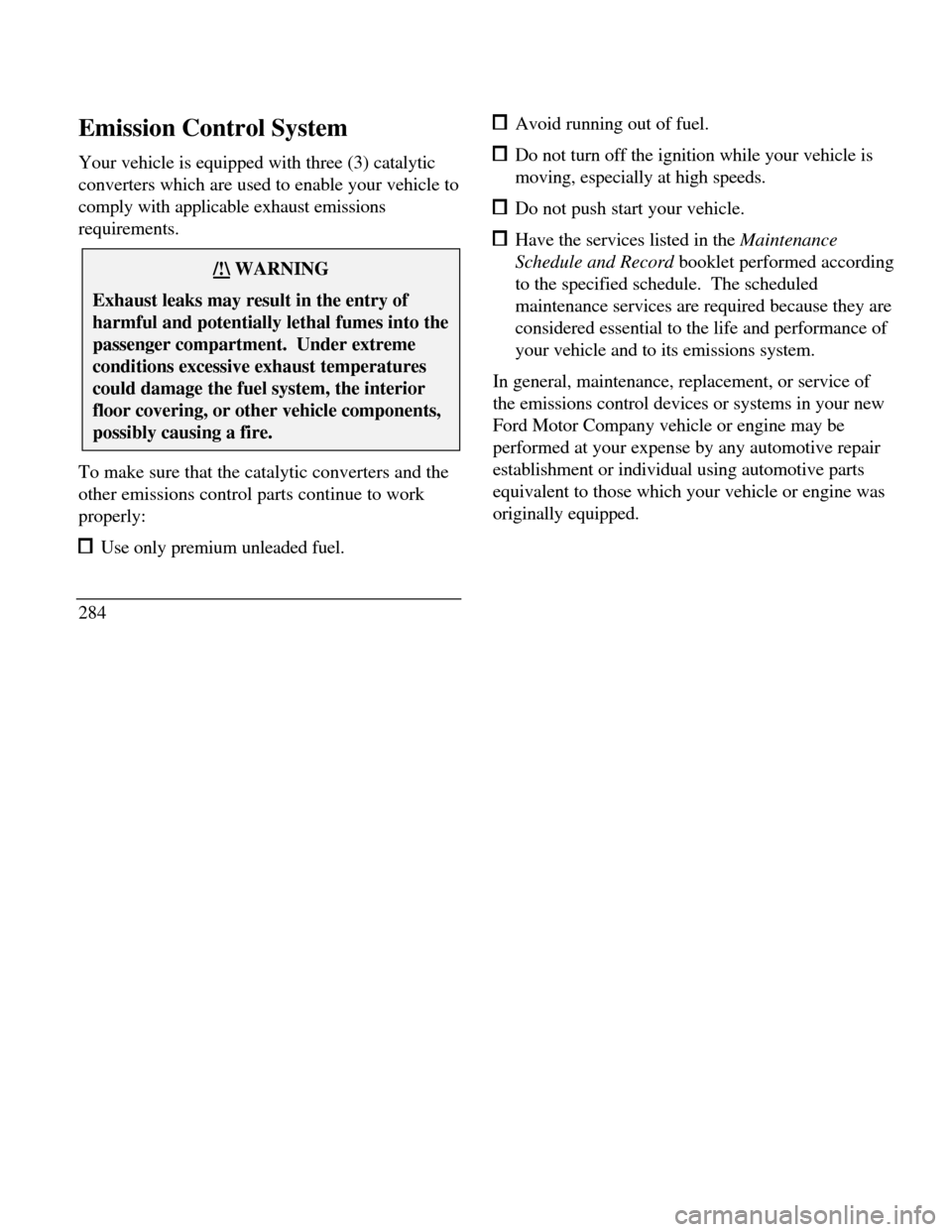Page 257 of 320
![LINCOLN CONTINENTAL 1996 Customer Assistance Guide (temperatures below 32°F [0°C]). State or local
regulations on Volatile Organic Compounds
(VOCs) may restrict use of the most common
antifreeze, methanol. Washer fluids containing non-
methanol a LINCOLN CONTINENTAL 1996 Customer Assistance Guide (temperatures below 32°F [0°C]). State or local
regulations on Volatile Organic Compounds
(VOCs) may restrict use of the most common
antifreeze, methanol. Washer fluids containing non-
methanol a](/manual-img/15/6872/w960_6872-256.png)
(temperatures below 32°F [0°C]). State or local
regulations on Volatile Organic Compounds
(VOC's) may restrict use of the most common
antifreeze, methanol. Washer fluids containing non-
methanol antifreeze agents should be used only if
they provide cold weather protection without
damaging the vehicle's paint finish, wiper blades,
and windshield washer system.
Wiper Blades
Check the windshield wiper blades at least twice a
year. Also check them whenever they seem less
effective than usual. Substances such as tree sap
and some hot wax treatments used by commercial
car washes reduce the effectiveness of wiper blades.
If the blades do not wipe properly, clean both the
windshield and the wiper blades. Use undiluted
windshield washer solution or a mild detergent.
Rinse thoroughly with clear water. Do not use fuel,
kerosene, paint thinner, or other solvents to clean
your wiper blades. These will damage your blades.To make reaching the wiper blades easy, simply turn
the ignition to the ACC position and turn your
wipers on. Wait for them to reach a vertical position
and turn the ignition to the OFF position. Do not
move the wipers manually. Manually moving the
wipers across the windshield may damage them.
Wiper blade replacement
If the wiper blades still do not work properly after
you clean them, you may need to replace the wiper
blade assembly or the blade element. When replacing
the wiper blade assembly, blade refill, or wiper arm
always use a Motorcraft part or equivalent. To
replace the blades, follow the instructions that come
with them.
Tires
Look at your tires each time you fill your fuel tank.
If one tire looks lower than the others, check the
pressure in all of them. Always follow these
precautions:
255
Page 262 of 320

loading, either separately or in combination, can
cause heat buildup and possible tire failure.
Snow tires
The tires on your vehicle have all-weather treads
that provide traction in rain or snow. However,
during the winter months in some climates, you may
need to use snow tires.
Use of tire chains is not recommended. The use of
tire chains could result in damage to your vehicle./!\ WARNINGSnow tires must be the same size and gradeas the tires you Currently have on yourvehicle.Cleaning the Wheels
Wash the wheels with the same detergent you use
to wash your vehicle's body. Do not use acid-based
wheel cleaners, steel wool, abrasives, fuel, or strong
260detergents. These substances will damage protective
coatings. Use tar and road oil remover to remove
grease and tar.
NOTE: Before going to a car wash, find out if the
brushes are abrasive.
If you have whitewall tires that are difficult to clean
with regular detergent, use whitewall tire cleaner.
Follow the directions on the container and rinse the
tires with plenty of clean water.
Securitires (If equipped)
Securitires are designed to allow you to continue
driving your Continental a limited number of miles
when one of your vehicle's tires is at low or even
zero air pressure./!\ WARNINGDo not use aerosol tire inflator/sealer withSecuritires. Doing so may damage the tire'spressure sensor.
Page 271 of 320

The Instrument Panel Fuses
Fuse
Location Fuse Amp
RatingDescription110An And-theft indicator light
n PWM dimming output for
microphone illumination,
ashtray illumination (R & L
rear door),heated seat
switches, heated backlight
switch, EATC control panel,
message center switches, cigar
lighter, console shift
illumination, navigation
display module, and
navigation switches210An Luxury radio
n Clock (non-navigational)
n Cellular phone310An Multi-function switch410An Run/Accessory sensor
(luxury radio)
n Cellular phone
n Run/Accessory sensor
(LCM)
n Window switches
backlight RF, LR, RR) *
n CompassFuse
LocationFuse Amp
RatingDescription4 (cont.)10A
· E/C mirror
· Stand alone clock
· Door lock switches backlight510A
· Virtual image cluster
· Light sensor (Autolamp)
· Traction Assist OFF switch
· Airbag diagnostic
· Luxury radio FCU
· Run/Start sensor (LCM)65A
· SCP network715A
· Right front turn lamp
· Right turn indicator
· HI beam switch
· Right and left front side
marker lamps
· Right and left front park
lamps
· Right and left front tail
lamps
· Right rear stop/turn lamps830A
· Fuel filler
· Trunk solenoid
· Navigation system power269
Page 277 of 320
Fuse
LocationMaxi-Fuse
Amp RatingDescription22Not used23Relay
· HI beam headlamps relay2420A
· Fuel pump2520A
· Thermactor pump26Relay
· EATC blower motor relay2730A
· PCM
· STC28Not used29Relay
· Horns relay30Relay
· Powertrain control module
relayChecking and Replacing Fuses
If you need to check a fuse, follow these steps:
1. Find the fuse panel underneath the instrument
panel to the left of the steering column.
Squeeze together the two areas indicated by
the arrows and pull down to remove the
cover.
2. Find the fuse you want to check (fuses are
numbered on the fuse panel) and remove it
with the fuse pulling tool that is provided.
3. Check the fuse to see if it is blown. Look
through the clear side of the fuse to see if the
metal wire inside is separated. If it is, the fuse
should be replaced.
275
Page 286 of 320

Emission Control System
Your vehicle is equipped with three (3) catalytic
converters which are used to enable your vehicle to
comply with applicable exhaust emissions
requirements./!\ WARNINGExhaust leaks may result in the entry ofharmful and potentially lethal fumes into thepassenger compartment. Under extremeconditions excessive exhaust temperaturescould damage the fuel system, the interiorfloor covering, or other vehicle components,possibly causing a fire.To make sure that the catalytic converters and the
other emissions control parts continue to work
properly: Use only premium unleaded fuel.
284 Avoid running out of fuel. Do not turn off the ignition while your vehicle is
moving, especially at high speeds. Do not push start your vehicle. Have the services listed in the Maintenance
Schedule and Record booklet performed according
to the specified schedule. The scheduled
maintenance services are required because they are
considered essential to the life and performance of
your vehicle and to its emissions system.
In general, maintenance, replacement, or service of
the emissions control devices or systems in your new
Ford Motor Company vehicle or engine may be
performed at your expense by any automotive repair
establishment or individual using automotive parts
equivalent to those which your vehicle or engine was
originally equipped.
Page 287 of 320

Ford strongly recommends the use of genuine Ford
replacement parts. If other than Ford or
Motorcraft parts or Ford authorized
remanufactured parts are used for maintenance
replacements or for the service of components
affecting emission control, such non-Ford parts
should be equivalent to genuine Ford Motor
Company parts in performance and durability. It is
the owner's responsibility to determine the
equivalency of such parts. Please consult your
warranty booklet for complete warranty
information./!\ WARNINGDo not park, idle, or drive your vehicle in drygrass or other dry ground cover. Theemission system heats up the enginecompartment and exhaust system, which canstart a fire.Watch for fluid leaks, strange odors, smoke, loss
of oil pressure, the charge warning light, the checkengine light, or the temperature warning light. These
sometimes indicate that the emission system is not
working properly.
Do not make any unauthorized changes to your
vehicle or engine. Changes that cause more unburned
fuel to reach the exhaust system can increase the
temperature of the engine or exhaust system.
By law, anyone who manufactures, repairs, services,
sells, leases, trades vehicles, or supervises a fleet of
vehicles is not permitted to intentionally remove an
emission control device or prevent it from working.
In some of the United States and in Canada, vehicle
owners may be liable if their emission control device
is removed or is prevented from working.
Do not drive your vehicle if it does not operate
properly. See your dealer if the engine runs on for
more than five seconds after you shut it off or if it
misfires, surges, stalls, or backfires.
285
Page 289 of 320

3.Drive to accumulate at least four (4) minutes
in the range of 30-45 mph (50-70 km/h). If
stop and go conditions occur, the
accumulative time must be within the 30-45
mph (50-70 km/h) range. No wide open
throttle conditions should be encountered.
4.Cruise and maintain a select speed in the range
of 30-40 mph (48-64 km/h) on a level road
with throttle held very steady for at least one
(1) minute.
5.Decelerate and idle for at least 80 seconds.
6.Accelerate to 55 mph (90 km/h) at ½ throttle.
7.Decelerate at closed throttle for I 0 seconds.
8. Cruise and maintain a select speed in the range
of 40-65 mph (64-105 km/h) on a level road
with throttle held very steady for at least 80
seconds.9. Complete 10 minutes of city driving 25-40 mph
(40-64 kin/h) with at least six (6) stops.
10. OBD II drive cycle has been completed.
Vehicle can be turned off when convenient.
Refill Capacities, Motorcraft Parts,
and Lubricant Specifications
Refill Capacities
ComponentU.S.MetricCooling system
(including heater)14.25 qts.13.5 litersEngine oil
(with filter change)6.0 qts.5.7 litersTransaxle
Auto. overdrive13.7 qts.13.0 litersPower steering2.5 pints1.2 litersFuel tank17.8 gallons67.4 litersPressure cap16 psiI 10 kPa287
Page 290 of 320
Motorcraft Parts
If you replace
these parts ...Use the Motorcraft Service
Part with this part number· spark plug*AWSF-32EE**· air filterFA-1615· fuel filterFG-800A· oil filterFL-820· batterystandardBXT-65-850*Refer to Vehicle Emission Control Information (VECI)
decal for spark plug and gap specifications.
**If a spark plug is removed for examination, it must be
reinstalled in the same cylinder.
Cylinders #1, #2, 43, #4 have a EG suffix.
Cylinders #5, #6, #7, #8 have a E suffix.
If a spark plug needs to be replaced, use only spark plugs
with the I service number suffix letter "FE" as shown on the
engine decal.288